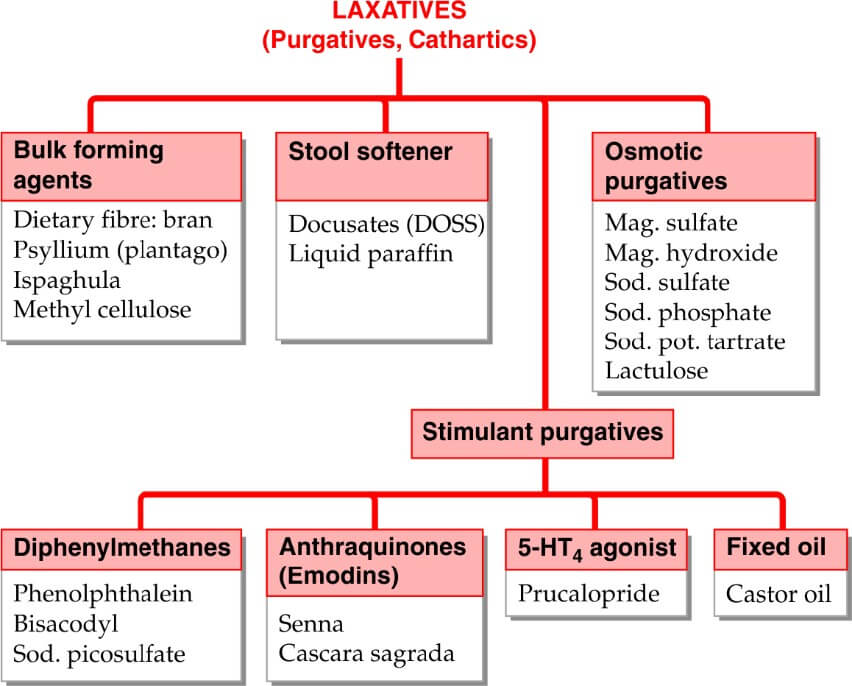
These are drugs that promote evacuation of bowels. A distinction is sometimes made according to the intensity of action. Many drugs in low doses act as laxative and in larger doses as purgative.
-
- Laxative or aperient: milder action, elimination of soft but formed stools.
- Purgative or cathartic: stronger action resulting in more fluid evacuation.
Table of Contents
MECHANISM OF ACTION
All purgatives increase the water content of the faeces by:
-
- A hydrophilic or osmotic action, retaining water and electrolytes in the intestinal lumen—increase volume of colonic content and make it easily propelled.
- Acting on intestinal mucosa, decrease net absorption of water and electrolyte; intestinal transit is enhanced indirectly by the fluid bulk.
- Increasing propulsive activity as primary action—allowing less time for absorption of salt and water as a secondary effect.
For some of the drugs, controversy continues as to whether they increase water content of stools as the primary action or it is a consequence of increased motility, because the amount of water absorbed largely depends on transit time. However, certain purgatives do increase motility through an action on the myenteric plexuses.
Laxatives modify the fluid dynamics of the mucosal cell and may cause fluid accumulation in gut lumen by one or more of following mechanisms:
-
- Inhibiting Na+K+ ATPase of villous cells— impairing electrolyte and water absorption.
- Stimulating adenylyl cyclase in crypt cells— increasing water and electrolyte secretion.
- Enhancing PG synthesis in mucosa which increases secretion.
- Increasing NO synthesis which enhances secretion and inhibits non-propulsive contrations in colon.
- Structural injury to the absorbing intestinal mucosal cells.
OSMOTIC PURGATIVES
Solutes that are not absorbed in the intestine retain water osmotically and distend the bowel— increasing peristalsis indirectly.
MOA
Magnesium ions release cholecystokinin which augments motility and secretion, contributing to purgative action of Mag. salts. All inorganic salts used as osmotic (saline) purgatives have similar action—differ only in dose, palatability and risk of systemic toxicity.
- Mag. sulfate (Epsom salt): 5–15 g; bitter in taste, may nauseate.
- Mag. hydroxide (as 8% W/W suspension—milk of magnesia) 30 ml; bland in taste, also used as antacid.
- Sod. Sulfate (Glauber’s salt): 10–15 g; bad in taste.
- Sod. Phosphate: 6–12 g, taste not unpleasant.
- Sod. Pot. Tartrate (Rochelle salt): 8–15 g, relatively pleasant tasting.
The salts taken in above mentioned doses, dissolved in 150–200 ml of water, produce 1–2 fluid evacuations within 1–3 hours with mild cramping; cause nearly complete emptying of bowels. Smaller doses may have a milder laxative action.
Mag. salts are contraindicated in renal insufficiency, while Sod. salts should not be given to patients of CHF and other Sod. retaining states. Repeated use of saline purgatives can cause fluid and electrolyte imbalance.
Saline purgatives are not used now for the treatment of constipation because they are inconvenient/unpleasant, produce watery stools and after constipation. However, they may be preferred for preparation of bowel before surgery and colonoscopy; in food/drug poisoning and as after-purge in the treatment of tapeworm infestation.
Lactulose
It is a semisynthetic disaccharide of fructose and lactose which is neither digested nor absorbed in the small intestine—retains water.
Further, it is broken down in the colon by bacteria to osmotically more active products. In a dose of 10 g BD taken with plenty of water, it produces soft formed stools in 1–3 days.
Flatulence and flatus is common, cramps occur in few. Some patients feel nauseated by its peculiar sweet taste.
In patients with hepatic encephalopathy, lactulose causes reduction of blood NH3 concentration by 25–50%. The breakdown products of lactulose are acidic—lower the pH of stools. Ammonia produced by bacteria in colon is converted to ionized NH +4 salts that are not absorbed.
For this purpose 20 g TDS or more may be needed. Loose motions are produced at this dose.
Other drugs used to reduce blood NH3 in hepatic coma are Sod. benzoate and Sod. phenyl acetate. They combine with NH3 in blood to form hippuric acid or phenyl acetic glutamine respectively: these are rapidly excreted in urine.
Uses of Purgatives
|
Functional Constipation |
|
|
|
Bedridden Patient |
|
|
|
To avoid staining at stool |
|
|
|
Preparation of bowel for surgery, colonoscopy, Abdominal X-ray |
| |
|
After certain anthelmintic |
| |
|
Food/ drug poisoning |
| |


